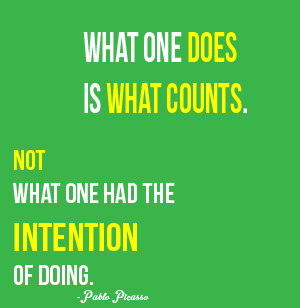“What one does is what counts. Not what one had the intention of doing.”
― Pablo Picasso
If you clicked on this article, you likely have the intention to become a great clinical informaticist who delivers consistent results and is always on top of things. We hope that the three items listed below can help you move from intention towards action by helping you with quick and easy things to do to start moving towards greatness.
We’ll recommend that as you go through this article, you think of possible ways to implement these thoughts and actions into your professional life and take just two minutes of your time to work on one area for improvement.
1. Be Proactive
When you work in a reactive environment where the latest work emergencies and deadlines linger over the heads of every staff member, taking a proactive approach to the workplace is tough. Real tough.
Try taking one of the steps below to start becoming a more proactive informaticist. But first of all, eliminate, eliminate, eliminate. Especially those time wasting or filling tasks. Then fill that newly free time with some of the examples below.
- Improve an existing process. Get rid of unnecessary steps, automize when possible, and understand the “why” of the process.
- Think and plan ahead for possible problems and solutions. How about creating a data breach response plan, a process flowchart, or something else your organization needs but it seems no one has gotten around to yet.
- Prioritize tasks, then get rid of unnecessary ones to free up time for longer-term planning (David Allen’s Getting Things Done: The Art of Stress-Free Productivity
is the best resource for this kind of thing)
- Teach yourself something new in the field. If you usually analyze data with R, maybe play around with Hadoop. If you look all day at clinical workflows, maybe learn a little bit more about the IT workflows.
2. Keep up on the Latest in Clinical Informatics
Part two of this advice: Also keep you boss up-to-date on the latest in clinical informatics.
If a topic comes up in one of her meetings that is related to an article you showed her prior to the meeting, not only is she going to look good, but she’ll be grateful that you helped her look good and you will be rewarded. Trust us.
The Clinical Informatics News section of this site
Journal of Applied Clinical Informatics
3. Pay Attention to Detail While Keeping an Eye on the Big Picture
As a clinical informaticist, you have a tough job of dealing with the nitty gritty details of data while having to transform those small pieces of data into something that be easily summed up.
Sometimes you can’t see the forest because the trees are in the way. The point where you take a step back from the trees to see the forest requires more introspective thinking and reflecting. Many don’t take the time to reflect, as it is often overlooked for short-term progress. Here is just one action you can take to help see the forest and the trees.
Every morning plan out your day and come up with two tasks for the day. Two tasks. That’s it. You can do that, right?
- Plan one task or activity for the day that will help move you towards a 1 week to 1 month out goal
- Plan one task or activity to complete that will help move you towards a goal that is a year out from now
- Execute on those tasks
Or you can try the following –
- At the end of the day, write down one good thing that happened during that day and one thing you could have done better
- Keep a running list and as time progresses, look back on your accomplishments to see just how far you’ve come
Two Minutes is All it Takes
If you can take two minutes from your day today to eliminate an unnecessary task, look up a new informatics article, or write down a goal for the next year, we know that you will become a great clinical informaticist because you not only know what’s going on in the industry, but can guide your organization in the right direction and be a valuable member of any time. And those skills are invaluable to any organization.
[GARD]
